2018 MITSUBISHI OUTLANDER III weight
[x] Cancel search: weightPage 224 of 441

Rear-view camera (if so equipped)
Features and controls 5-143
5
The rear-view camera (A) is in the liftgate, atthe left side of
the liftgate handle.
Reference lines and uppe
r surface of the rear
bumper (A) are displayed on the screen. Red line (B) indicates approximately 20inches (50 cm) behind the rear bumper.Two Green lines (C) indicate approxi-mately 8 inches (20 cm) outside of thevehicle body.Short transverse lines (1
to 3) indicate dis-
tance from the rear bumper.
Location of rear-view camera
CAUTIONIf the camera lens gets
dirty, a clear image
cannot be obtained. As
necessary, rinse the
lens with clean water a
nd gently wipe with a
clean, soft cloth.To avoid damaging the camera;• Do not rub the cover excessively or polishit by using an abrasive compound. • Do not disassemble the camera.• Do not splash hot wate
r directly on the lens.
• Do not spray the camera and its surround-ings with high-
pressure water.
• Make sure that the liftgate is securelyclosed when backing up.
Reference lines on the screen
1: Approximately at the rear edge of the
rear bumper
2: Approximately 39 inches (100 cm) 3: Approximately 79 inches (200 cm)
CAUTIONThe rear-view camera uses a wide-anglelens. As a result, images and distances shownon the screen are not exact.Actual distance may be different from dis-tance indicated by the
lines on the screen,
depending on the loadi
ng condition of the
vehicle and road surface condition.The reference lines for distance and vehiclewidth are based on a level, flat road surface.In the following cases, objects shown on thescreen will appear to
be farther off than they
actually are.• When the rear of th
e vehicle is weighed
down with the weight of passengers andluggage in the vehicle. (Case 1)• When there is an upward slope at the back.(Case2)
Case 1A- Actual objectsB- Objects shown on the screen
BK0249100US.book 143 ページ 2017年5月10日 水曜日 午前8時49分
Page 232 of 441
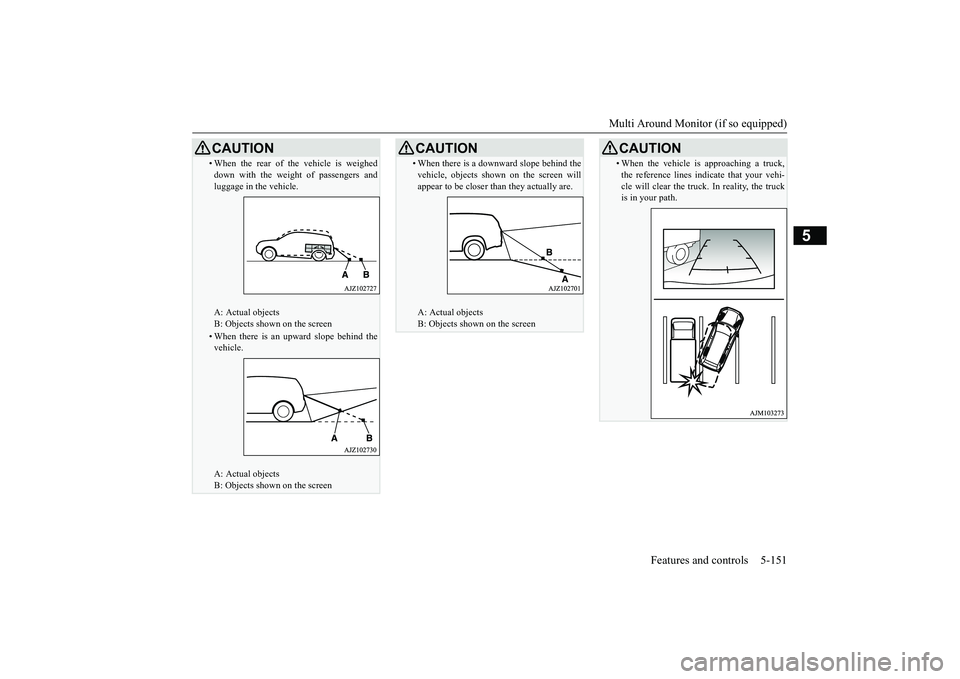
Multi Around Monitor (if so equipped)
Features and controls 5-151
5
• When the rear of th
e vehicle is weighed
down with the weight of passengers andluggage in the vehicle.A: Actual objectsB: Objects shown on the screen• When there is an upward slope behind thevehicle.A: Actual objectsB: Objects shown on the screenCAUTION
• When there is a downward slope behind thevehicle, objects shown on the screen willappear to be closer than they actually are.A: Actual objectsB: Objects show
n on the screen
CAUTION
• When the vehicle is
approaching a truck,
the reference lines indi
cate that your vehi-
cle will clear the truck. In reality, the truckis in your path.CAUTION
BK0249100US.book 151 ページ 2017年5月10日 水曜日 午前8時49分
Page 327 of 441
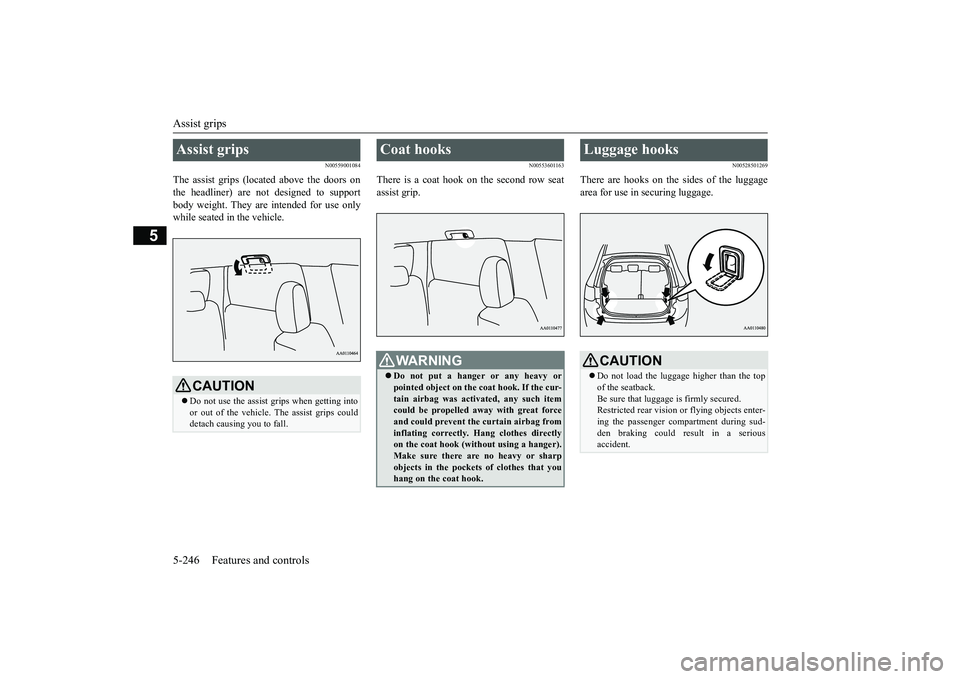
Assist grips5-246 Features and controls
5
N00559001084
The assist grips (located above the doors onthe headliner) are not designed to supportbody weight. They are intended for use onlywhile seated in the vehicle.
N00553601163
There is a coat hook on the second row seatassist grip.
N00528501269
There are hooks on the sides of the luggagearea for use in securing luggage.
Assist grips
CAUTIONDo not use the assist grips when getting intoor out of the vehicle.
The assist grips could
detach causing you to fall.
Coat hooks
WA R N I N GDo not put a hanger or any heavy orpointed object on the
coat hook. If the cur-
tain airbag was activated, any such itemcould be propelled away with great forceand could prevent the curtain airbag frominflating correctly.
Hang clothes directly
on the coat hook (without using a hanger).Make sure there ar
e no heavy or sharp
objects in the pocket
s of clothes that you
hang on the coat hook.
Luggage hooks
CAUTIONDo not load the luggage higher than the topof the seatback.Be sure that luggage
is firmly secured.
Restricted rear vision or
flying objects enter-
ing the passenger compartment during sud-den braking could result in a seriousaccident.
BK0249100US.book 246 ページ 2017年5月10日 水曜日 午前8時49分
Page 335 of 441
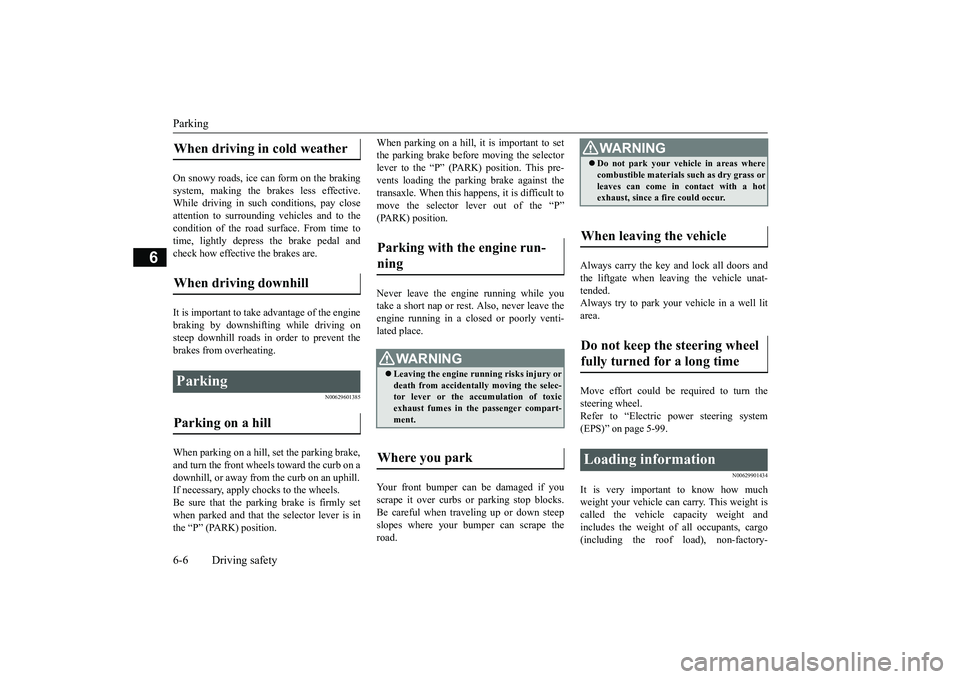
Parking6-6 Driving safety
6
On snowy roads, ice can form on the brakingsystem, making the brakes less effective.While driving in such conditions, pay closeattention to surrounding
vehicles and to the
condition of the road surface. From time totime, lightly depress the brake pedal andcheck how effective the brakes are.It is important to take
advantage of the engine
braking by downshifting while driving onsteep downhill roads in order to prevent thebrakes from overheating.
N00629601385
When parking on a hill, set the parking brake,and turn the front wheels toward the curb on adownhill, or away from
the curb on an uphill.
If necessary, apply chocks to the wheels.Be sure that the parki
ng brake is firmly set
when parked and that the selector lever is inthe “P” (PARK) position.
When parking on a hill, it is important to setthe parking brake befo
re moving the selector
lever to the “P” (PARK) position. This pre-vents loading the parking brake against thetransaxle. When this ha
ppens, it is difficult to
move the selector lever out of the “P”Never leave the engine running while youtake a short nap or rest. Also, never leave theengine running in a closed or poorly venti-lated place.Your front bumper can be damaged if youscrape it over curbs or parking stop blocks.Be careful when traveling up or down steepslopes where your bumper can scrape theroad.
Always carry the key and lock all doors andthe liftgate when leaving the vehicle unat-tended.Always try to park your vehicle in a well litarea.Move effort could be required to turn thesteering wheel.Refer to “Electric power steering system(EPS)” on page 5-99.
N00629901434
It is very important to know how muchweight your vehicle can carry. This weight iscalled the vehicle ca
pacity weight and
includes the weight of
all occupants, cargo
(including the roof load), non-factory-
When driving in cold weather When driving downhill Parking Parking on a hill
Parking with the engine run-ning
WA R N I N GLeaving the engine ru
nning risks injury or
death from accidentally moving the selec-tor lever or the accumulation of toxicexhaust fumes in the passenger compart-ment.
Where you park
WA R N I N GDo not park your vehicle in areas wherecombustible materials
such as dry grass or
leaves can come in contact with a hotexhaust, since a fire could occur.
When leaving the vehicle Do not keep the steering wheel fully turned for a long time Loading information
BK0249100US.book 6 ページ 2017年5月10日 水曜日 午前8時49分
Page 336 of 441
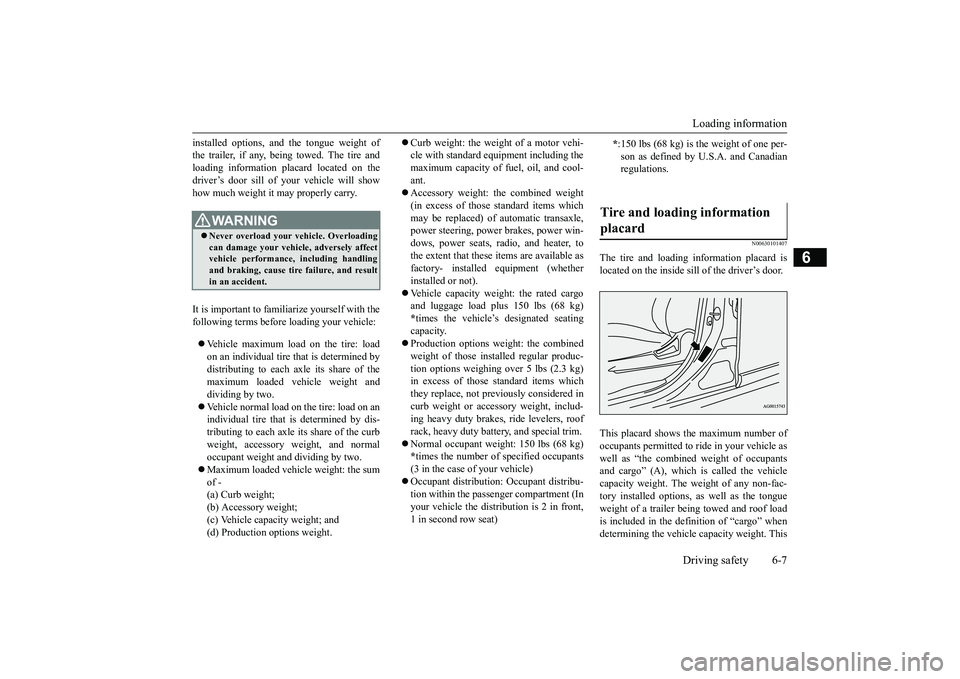
Loading informationDriving safety 6-7
6
installed options, and
the tongue weight of
the trailer, if any, being towed. The tire andloading information placard located on thedriver’s door sill of your vehicle will showhow much weight it may properly carry.It is important to famil
iarize yourself with the
following terms before loading your vehicle:Vehicle maximum load on the tire: loadon an individual tire that is determined bydistributing to each axle its share of themaximum loaded vehicle weight anddividing by two.Vehicle normal load on the tire: load on anindividual tire that is determined by dis-tributing to each axle its share of the curbweight, accessory weight, and normaloccupant weight and dividing by two.Maximum loaded vehicle weight: the sumof -(a) Curb weight;(b) Accessory weight;(c) Vehicle capacity weight; and(d) Production options weight.
Curb weight: the weight of a motor vehi-cle with standard equipment including themaximum capacity of
fuel, oil, and cool-
ant.Accessory weight: the combined weight(in excess of those st
andard items which
may be replaced) of automatic transaxle,power steering, power brakes, power win-dows, power seats, radio, and heater, tothe extent that these items are available asfactory- installed equipment (whetherinstalled or not).Vehicle capacity weight: the rated cargoand luggage load plus 150 lbs (68 kg)*times the vehicle’s designated seatingcapacity.Production options weight: the combinedweight of those installed regular produc-tion options weighing over 5 lbs (2.3 kg)in excess of those standard items whichthey replace, not prev
iously considered in
curb weight or accessory weight, includ-ing heavy duty brakes,
ride levelers, roof
rack, heavy duty battery, and special trim.Normal occupant weight: 150 lbs (68 kg)*times the number of
specified occupants
(3 in the case of your vehicle)Occupant distribution:
Occupant distribu-
tion within the passenger compartment (Inyour vehicle the distribution is 2 in front,1 in second row seat)
N00630101407
The tire and loading information placard islocated on the inside sill of the driver’s door.This placard shows the maximum number ofoccupants permitted to
ride in your vehicle as
well as “the combined
weight of occupants
and cargo” (A), which
is called the vehicle
capacity weight. The weight of any non-fac-tory installed options, as well as the tongueweight of a trailer being towed and roof loadis included in the defi
nition of “cargo” when
determining the vehicle
capacity weight. This
WA R N I N GNever overload your ve
hicle. Overloading
can damage your vehicl
e, adversely affect
vehicle performance, including handlingand braking, cause tire failure, and resultin an accident.
*:150 lbs (68 kg) is the weight of one per-son as defined by U.
S.A. and Canadian
regulations.
Tire and loading information placard
BK0249100US.book 7 ページ 2017年5月10日 水曜日 午前8時49分
Page 337 of 441
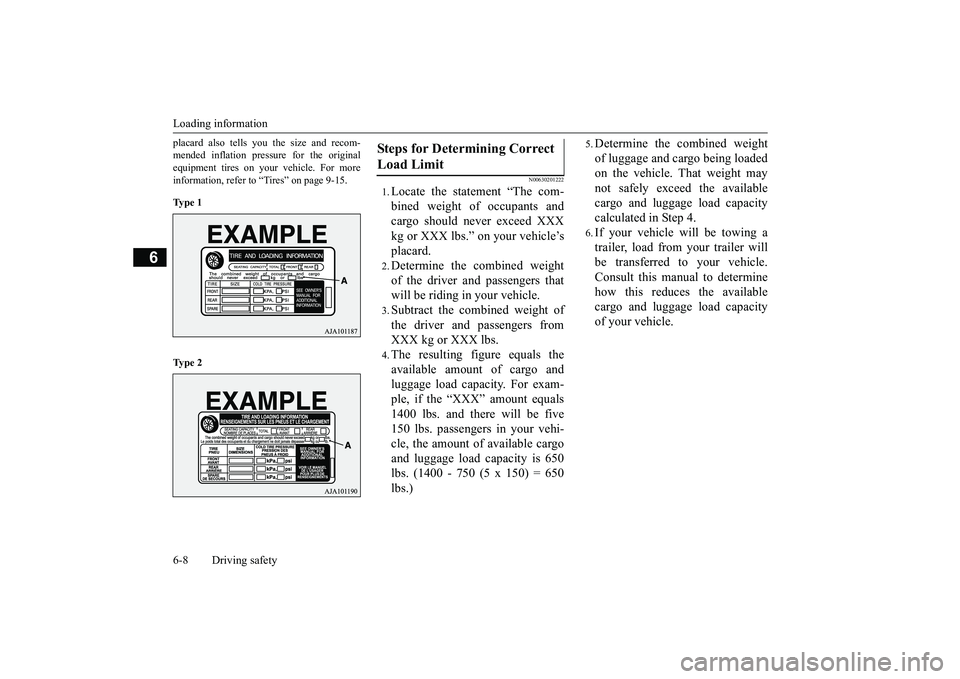
Loading information6-8 Driving safety
6
placard also tells you the size and recom-mended inflation pressure for the originalequipment tires on your vehicle. For moreinformation, refer to “Tires” on page 9-15.Ty p e 1Ty p e 2
N00630201222
1.Locate the statement “The com-bined weight of occupants andcargo should never exceed XXXkg or XXX lbs.” on your vehicle’splacard.2.Determine the combined weightof the driver and passengers thatwill be riding in your vehicle.3.Subtract the combined weight ofthe driver and passengers fromXXX kg or XXX lbs.4.The resulting figure equals theavailable amount of cargo andluggage load capacity. For exam-ple, if the “XXX” amount equals1400 lbs. and there will be five150 lbs. passengers in your vehi-cle, the amount of available cargoand luggage load
capacity is 650
lbs. (1400 - 750 (5 x 150) = 650lbs.)
5.Determine the combined weightof luggage and cargo being loadedon the vehicle. That weight maynot safely exceed the availablecargo and luggage load capacitycalculated in Step 4.6.If your vehicle will be towing atrailer, load from your trailer willbe transferred to your vehicle.Consult this manual to determinehow this reduces the availablecargo and luggage load capacityof your vehicle.
Steps for Determining Correct Load Limit
BK0249100US.book 8 ページ 2017年5月10日 水曜日 午前8時49分
Page 338 of 441
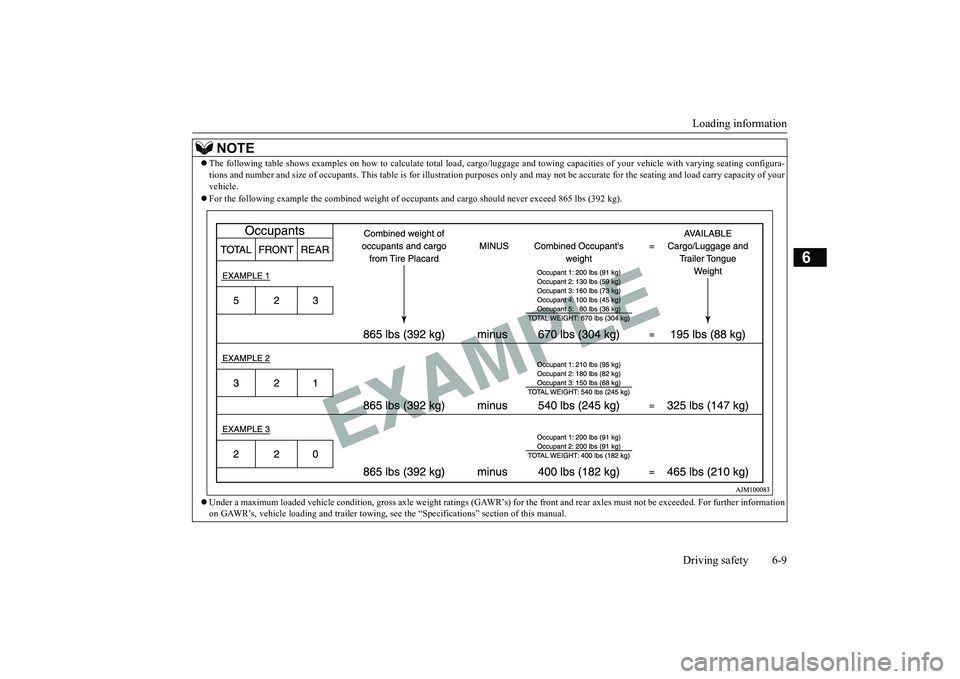
Loading informationDriving safety 6-9
6
NOTE
The following table shows examples on how to
calculate tota
l load, cargo/luggage and towing capa
cities of your vehicle with var
ying seating configura-
tions and number and size of occ
upants. This table is for illu
stration purposes only and may not
be accurate for the seating an
d load carry capacity of your
vehicle.For the following example the combined weight of oc
cupants and cargo should ne
ver exceed 865 lbs (392 kg).
Under a maximum loaded vehicle c
ondition, gross axle weight ratings (GAWR’s) for
the front and rear axles must not be exceeded.
For further information
on GAWR’s, vehicle loading and tr
ailer towing, see the “Specifica
tions” section of this manual.
BK0249100US.book 9 ページ 2017年5月10日 水曜日 午前8時49分
Page 339 of 441
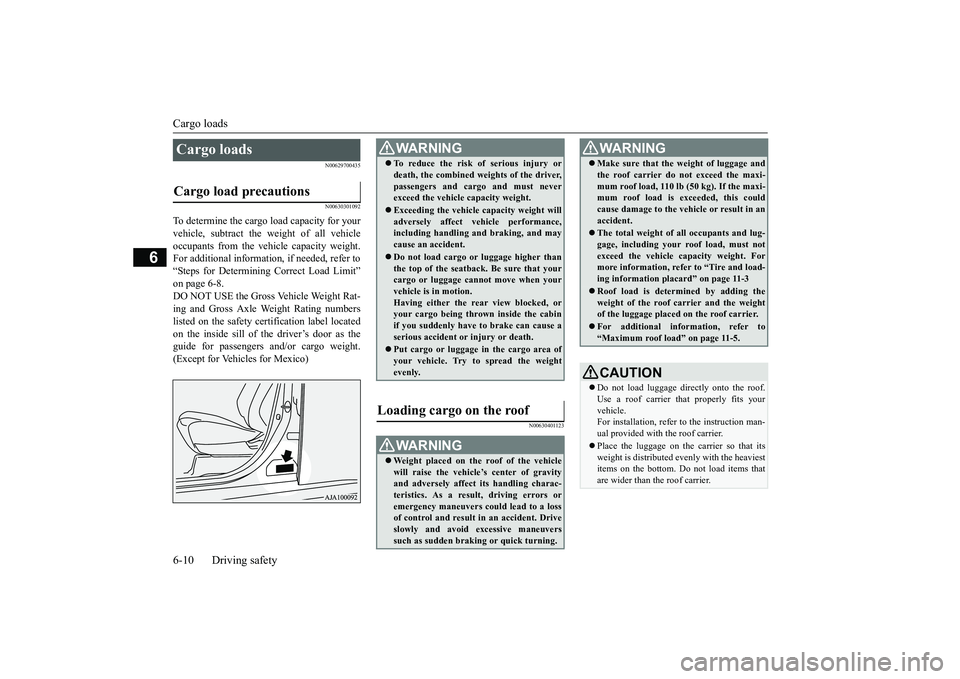
Cargo loads6-10 Driving safety
6
N00629700435N00630301092
To determine the cargo load capacity for yourvehicle, subtract the
weight of all vehicle
occupants from the vehi
cle capacity weight.
For additional information, if needed, refer to“Steps for Determining Correct Load Limit”on page 6-8.DO NOT USE the Gross Vehicle Weight Rat-ing and Gross Axle Weight Rating numberslisted on the safety certification label locatedon the inside sill of the driver’s door as theguide for passengers and/or cargo weight.(Except for Vehicles for Mexico)
N00630401123
Cargo loads Cargo load precautions
WA R N I N GTo reduce the risk of serious injury ordeath, the combined weights of the driver,passengers and cargo and must neverexceed the vehicle capacity weight.Exceeding the vehicle capacity weight willadversely affect ve
hicle performance,
including handling and braking, and maycause an accident.Do not load cargo or luggage higher thanthe top of the seatback. Be sure that yourcargo or luggage cann
ot move when your
vehicle is in motion.Having either the re
ar view blocked, or
your cargo being thrown
inside the cabin
if you suddenly have to brake can cause aserious accident or
injury or death.
Put cargo or luggage in the cargo area ofyour vehicle. Try to spread the weightevenly.
Loading cargo on the roof
WA R N I N GWeight placed on the
roof of the vehicle
will raise the vehicle’and adversely affect
its handling charac-
teristics. As a result, driving errors oremergency maneuvers could lead to a lossof control and result in an accident. Driveslowly and avoid excessive maneuverssuch as sudden brak
ing or quick turning.
Make sure that the
weight of luggage and
the roof carrier do not exceed the maxi-mum roof load, 110 lb (50 kg). If the maxi-mum roof load is ex
ceeded, this could
cause damage to the ve
hicle or result in an
accident.The total weight of all occupants and lug-gage, including your r
oof load, must not
exceed the vehicle capacity weight. Formore information, refer to “Tire and load-ing information placard” on page 11-3Roof load is determined by adding theweight of the roof
carrier and the weight
of the luggage placed
on the roof carrier.
For additional information, refer to“Maximum roof load” on page 11-5.CAUTIONDo not load luggage directly onto the roof.Use a roof carrier that properly fits yourvehicle.For installation, refer to the instruction man-ual provided with the roof carrier.Place the luggage on the carrier so that itsweight is distri
buted evenly with the heaviest
items on the bottom. Do not load items thatare wider than the roof carrier.WA R N I N G
BK0249100US.book 10 ページ 2017年5月10日 水曜日 午前8時49分